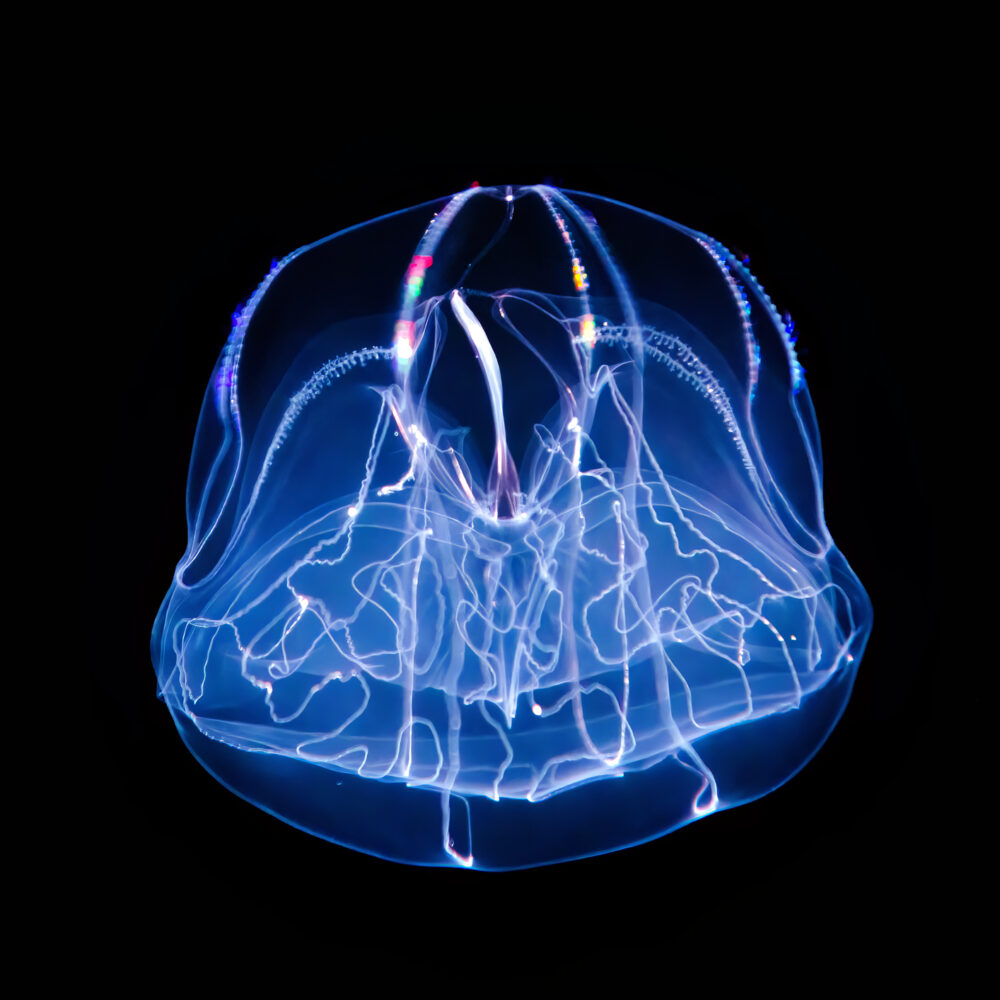Injured comb jellies can fuse into a single organism
An umbrella comb jelly is nearly invisible in the inky black waters of the deep sea. That see-through body disappears into the surrounding darkness and hides this delicate drifter from prowling predators.

Comb jellies, technically known as ctenophores, are one of the weirdest creatures on Earth. They appeared in the seas over half a billion years ago and have maintained to the present day the comb-like rows of cilia they used to move around. Their transparent bodies and internal bioluminescence give them looks that rival gaming computers. But there’s something that makes them even weirder.
When a comb jelly is injured, it can regenerate at an amazing rate. But it can also attach a body part of another injured comb jelly and integrate it near-seamlessly into its own body. (Those who have played Elden Ring can enjoy comparisons to Godrick The Grafted.)
“I’ve been observing ctenophores for a long time, so it was easy to spot an unusually large specimen. Some of the anatomical features were doubled, so I realized what I’m looking at is actually two individuals that have fused together,” said Kei Jokura, a marine researcher at the University of Exeter and lead author of a recent Current Biology paper on the integration of fused ctenophores.
Following an early Brooklynite
Jokura found his unusually large comb jelly, an individual belonging to the species, in a seawater retention tank where a population of these creatures is maintained for research purposes. It had two aboral ends—the part of a ctenophore body located opposite the oral end where the mouth is—and two apical organs the animal uses for sensing its environment.
Since Jokura’s first guess was that the strange creature he found was in fact two ctenophores fused with each other, he assembled the research team and started doing first experiments, like poking it on one of its lobes to see if the other would react to the stimuli. It did.
“At first, I thought that we discovered something entirely new. That nobody knows that ctenophores can fuse with each other. But then, we started doing literature surveys and found a paper published by B.R Coonfield in 1937 where he showed the results of grafting experiments done with ctenophores,” Jokura said.
Coonfield, a scholar at the Department of Biology at Brooklyn College, performed those experiments to prove that ctenophores possessed a special kind of symmetry in their anatomical features.
Coonfield used grafting, a technique used mainly in botany to merge two different plants into one, to see if the anatomy of ctenophores was indeed symmetrical. He didn’t think too much about their ability to survive the grafting, merely making a note that it occurred. Jokura, on the other hand, made it the main focus of his work.
Synchronizing comb jellies
First, Jokura and his team selected 10 pairs of healthy-looking ctenophores, cut them, and held them close together. “The individuals were immobilized, with little room for movement and a small gap between them. Gradually, we saw that gap closing, and finally, the individuals came into contact with each other,” Jokura said.
First, the comb jellies merged their membranes and epidermal parts, which constitute a two-cell-deep barrier protecting the inside of the animal from the environment. Once this was complete, their nervous systems started to merge, too. “The nerves got connected and electrical coupling happened. The muscle contractions started to synchronize. After 30 minutes, they were synchronized [to] 50 percent. After two hours, they were synchronized completely,” Jokura explained.
But not every system in these comb jellies merged seamlessly. “The pooping time depends on the individual, as each individual has its own metabolism that dictates when you want to poop,” Jokura said. The digestive systems in a fused comb jelly kept working seemingly independently of each other, with food going to either one or the other mouth and the waste being extracted from two separate anuses at different times.
Nine out of 10 pairs merged successfully and survived, and Jokura’s team documented the whole process on a time-lapse shot at one frame per second. “I think the most likely reason this 10th pair did not survive was the regeneration system was dysfunctional in either one or both individuals,” Jokura said.
The million-dollar question, though, was why ctenophores could fuse like that in the first place.
Evolution of fusion
From a purely mechanistic physiology standpoint, ctenophores can perform this grafting because they are relatively simple organisms. “Let’s take the nerve net. There was a Science paper last year that showed ctenophores had neurons but did not have synapses. I think this lack of synapses makes the merging process easier, makes the electrical coupling easier,” said Jokura.
Ctenophores can do without synapses because their neurons fuse together during development and share a continuous membrane called syncytium. It’s possible that the ability to integrate distinct cells and integrate distinct tissues shares an underlying mechanism.
Another reason fusion works is that the allorecognition system, which lets the organism tell self from non-self, is either very weak or non-existent in ctenophores. In humans, this system is active enough that transplanted organs are often rejected. Ctenophores are one of the earliest known multicellular organisms and perhaps come from a time before allorecognition systems started to appear.
The second option is that they evolved this ability as some kind of weird survival strategy. Badly injured ctenophores merging into one huge, super-scary ctenophore monster sounds like something straight out of a B-horror movie. Sadly, it’s highly unlikely that this is the case here.
“In the wild, they live separately from other ctenophores and they don’t constantly bump into each other unless there is something like a strong current or something external,” said Marianna Rodriguez-Santiago, a neuroscientist at Colorado State University and co-author of the paper.
So far, it’s too early to tell if the comb jelly fusion trick is a bug or a feature. “We’re not sure which is true. We are currently stuck with ‘it could be either one,’” said Rodriguez-Santiago.


